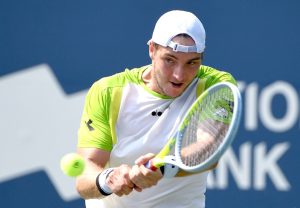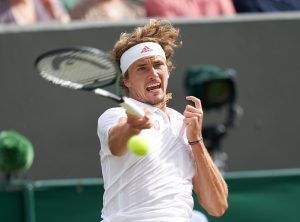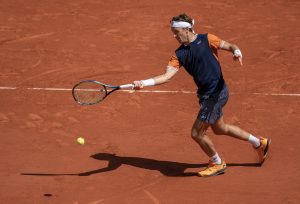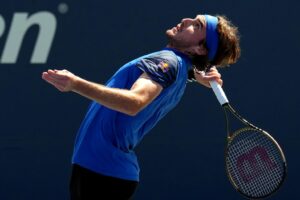This year’s ATP Finals at the O2 Arena will mark a full decade since the season-ending finale was first played in London. Only New York’s Madison Square Gardens, the setting for the tournament between 1977 and 1989, has hosted it for longer, and when the O2 hosts its final ATP Finals next year, the Pala Alpitour in Turin (the next host venue for the tournament, between 2021 and 2025) will have a hard act to follow.
Here are 10 highlights from 10 years of tennis at the O2, in ascending order.
- Nikolay Davydenko wins the first Tour Finals at the O2 in 2009
Nikolay Davydenko had a pretty spectacular career, reaching as high in the world rankings as No.3 at the end of 2006. However, the Russian never really translated his tour consistency into success at the Majors, with his best Grand Slam appearances being to twice reach the semi-finals of both the US and French Opens. Consequently, his career highlight is undoubtedly winning the first staging of the Tour Finals at the O2 in 2009, back when the tournament was called the “ATP World Tour Finals” (it became simply the “ATP Finals” in 2017). Davydenko defeated Roger Federer, who was seeking his third victory in the tournament in four years, in three sets in the semi-final and then saw off Juan Martín del Potro, fresh from his own heroics at the US Open (where he became the first man to beat Federer and Rafael Nadal at the same Major), in straight sets in the final, 6–3, 6–4.
- Jo-Wilfried Tsonga reaches the final in 2011
2011 was perhaps the best year in the career of Jo-Wilfried Tsonga, notwithstanding the fact that he reached his sole Major final at the Australian Open in 2008. At Wimbledon in 2011, he became the first man to defeat Roger Federer in a Major from two sets down by roaring back to win their quarterfinal in five sets, and he continued that fine form for the rest of the season. However, although he reached the final at the O2, Federer gained a modicum of revenge for Wimbledon by beating Tsonga in three sets in the final, 6–3, 6–7 (6–8), 6–3.
- Mike Bryan proves he can win without his brother in 2018
The mighty Bryans, the most successful men’s doubles pairing in tennis history, are so closely connected that they are invariably referred to in the plural. Last year, however, Mike Bryan proved that he could win big tournaments without his brother, Bob, who was recovering from the hip resurfacing surgery that Andy Murray has undergone this year. In Bob’s absence, Mike teamed up with fellow American Jack Sock, who had been a surprise qualifier for the singles at the O2 in 2017. First, they won two Major men’s doubles titles, at Wimbledon and the US Open, and then they capped off a superb 2018 by winning the doubles at the O2, beating the great French pairing of Nicolas Mahut and Pierre-Hugues Herbert 13-11 in a match tiebreak, after the first two sets had been shared.
- Grigor Dimitrov wins in 2017
The ATP Finals may not quite be a “fifth Major” (the unofficial title that Indian Wells likes to award itself), but it has still provided career highlights for several of its winners, especially in the era of “The Big Three”, who have hovered up most of the Majors between them. That was the case in 2009 with Nikolay Davydenko and again in 2017, when Grigor Dimitrov finally shed his dreaded “BabyFed” tag by winning at the O2. He defeated the aforementioned surprise qualifier, Jack Sock, in the semi-final and then beat David Goffin in three sets in the final, 7–5, 4–6, 6–3. Unfortunately for Dimitrov, the biggest win of his career (at least so far) did not quite prove to be the springboard to Major success that he had hoped it would be, as the following year’s winner also discovered.
- Alexander Zverev wins in 2018
For a time earlier this year, when he was suffering horribly with his serve, it appeared extremely unlikely that Alexander Zverev would be able to defend the ATP Tour Finals title that he had won so thrillingly in 2018, because it looked extremely unlikely that he would qualify for the tournament again this year. It almost seemed as if there was a bit of a curse developing because Zverev, just like the 2017 winner Grigor Dimitrov, had comprehensively failed to build on his supposed “breakthrough success”, especially in the Majors. However, a strong end to the season, including his run to the final of the Shanghai Masters, allowed Zverev to make it to London again, and now that he is here he will hope to repeat his success of 12 months ago.
- Novak Djokovic’s four successive wins
It is a testament to how much Novak Djokovic “djominated” men’s tennis in the mid-2010s that he won four successive ATP Tour titles between 2012 and 2015. Indeed, in 2014 he did not even need to take to the court, as Roger Federer defaulted through injury (more on that below). It all bolstered the image of Djokovic as the greatest hardcourt player ever, especially as he defeated both his major rivals in his other three winning Finals (Federer twice and Nadal once). Last year, after his near two-year career slump had ended with triumphs at both Wimbledon and the US Open, it appeared inevitable that he would win a fifth title at the O2 and a sixth overall (after his 2008 triumph in Shanghai). However, Alexander Zverev had other ideas, as he beat Djokovic in the final, but that will surely only make the great Serb even more determined to win this year, especially as doing so will take him back above Rafael Nadal in the world rankings and allow him to finish the year as World No.1 yet again.
- Roger Federer beats Stan Wawrinka in the 2014 semi-final
As mentioned above, Roger Federer was unable to play in the 2014 final. Ostensibly, that was because of injury but it may also have been because he was simply physically and emotionally shattered after his semi-final win over Stan Wawrinka, his fellow Swiss, the night before, which Federer eventually won in a third set tie-break (8-6) after losing the first set. And apparently there were some insults to add to the injury, as Federer’s wife, Mirka, was accused of audibly heckling Wawrinka towards the end of that match. All of which makes it all the more remarkable that the two greatest Swiss players ever were able to patch up their differences less than a week later, when they combined to win their country its first ever Davis Cup title by beating France in Lille.
- Roger Federer almost double-bagels Andy Murray in 2014
Even though he could not compete in the final, 2014 was certainly a memorable ATP Finals for Roger Federer, and not just because he beat Stan Wawrinka in their epic (if bad-tempered) semi-final. Earlier in the tournament, in the pool stage, he played one of his finest matches ever, and certainly in the period from 2012 to 2017 when he did not win a Major, as he beat Andy Murray 6-0, 6-1. Murray, who had finally won Wimbledon the year before (after beating Federer himself in the Olympic Singles Final at Wimbledon in 2012), was simply blown away by the Swiss maestro’s brilliance. Clearly, the memory of it has lingered, because earlier this year, when he was beginning his comeback from hip surgery, Murray recalled that thrashing in an interview, saying it was one of his worst ever moments as a professional.
- Andy Murray wins in 2016 and becomes year-end World No.1
In retrospect, the root cause of Andy Murray’s long and ongoing injury problems might be the extraordinary run that he went on at the end of 2016, the year of his second Wimbledon triumph, as he crossed and double-crossed the globe at the end of the season in pursuit of enough ranking points to take him to World No.1, making him the only man other than Federer, Nadal and Djokovic to reach the top of the men’s game in the previous 13 years. He actually first became No.1 at the Paris Masters, just before the ATP Finals, but it was his extraordinary straight-sets win (6–3, 6–4) over Novak Djokovic in the Final at the O2 that meant he ended 2016 as the highest-ranked male tennis player in the world. That, even more than his two Olympic Singles Gold medals, is ultimately what sets him apart from Stan Wawrinka as the fourth best player in this Golden Age in men’s tennis. Both men have won the same number of Majors (three), but Wawrinka has never been World No.1, and certainly not at the end of a season.
- Giving British tennis fans an alternative to Wimbledon
Of course, the real highlight at the O2 over the last 10 years has been the tournament itself, because it has provided British tennis fans with an alternative to Wimbledon, which is undoubtedly the world’s greatest tennis tournament but which is almost impossible to get tickets for. By bringing the world’s best eight male players to London and having them play indoors in an atmosphere that is the absolute antithesis of the occasionally stuffy atmosphere at SW19, the ATP Finals at the O2 has been a huge success, as borne out by the record visitor numbers, which, even if they have declined slightly in recent years, are still far higher than for any other venue that has hosted the tournament.
Of course next year will be the last time (at least for the foreseeable future) that the ATP Finals will be staged at the O2, before the great traveling caravan decamps to Italy. In its absence, the hope of all British tennis fans will be that if the ATP ever adds another Masters event, or moves an existing event from its current host city, London gets its own Masters tournament, which will be some compensation for the loss of the ATP Finals.
Main Photo:
Embed from Getty Images






